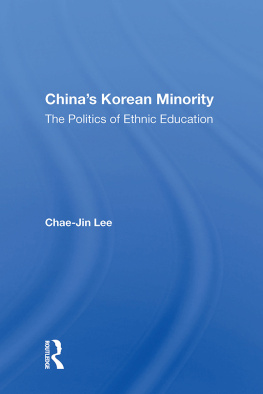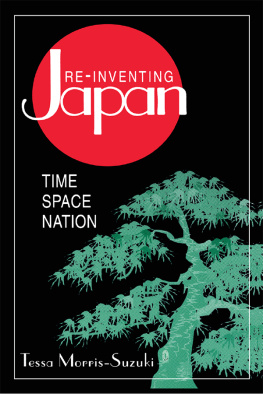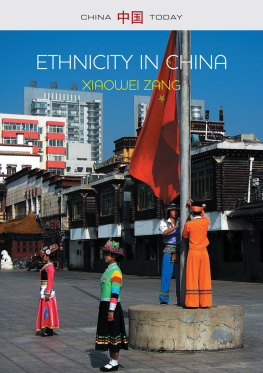STUDIES ON ETHNIC GROUPS IN CHINA
STEVAN HARRELL, EDITOR
STUDIES ON ETHNIC GROUPS IN CHINA
Cultural Encounters on Chinas Ethnic Frontiers
Edited by Stevan Harrell
Guest People: Hakka Identity in China and Abroad
Edited by Nicole Constable
Familiar Strangers: A History of Muslims in Northwest China
Jonathan N. Lipman
Lessons in Being Chinese: Minority Education and Ethnic Identity in Southwest China
Mette Halskov Hansen
Manchus and Han: Ethnic Relations and Political Power in Late Qing and Early Republican China, 18611928
Edward J. M. Rhoads
Ways of Being Ethnic in Southwest China
Stevan Harrell
Governing Chinas Multiethnic Frontiers
Edited by Morris Rossabi
On the Margins of Tibet: Cultural Survival on the Sino-Tibetan Frontier
shild Kols and Monika P. Thowsen
The Art of Ethnography: A Chinese Miao Album
Translation by David M. Deal and Laura Hostetler
Doing Business in Rural China: Liangshans New Ethnic Entrepreneurs
Thomas Heberer
Communist Multiculturalism: Ethnic Revival in Southwest China
Susan K. McCarthy
COMMUNIST
MULTICULTURALISM
ETHNIC REVIVAL IN SOUTHWEST CHINA
SUSAN K. McCARTHY

THIS PUBLICATION IS SUPPORTED IN PART
BY THE DONALD R. ELLEGOOD INTERNATIONAL
PUBLICATIONS ENDOWMENT.
2009 by the University of Washington Press
Printed in the United States of America
Design by Pamela Canell
14 12 11 10 09 5 4 3 2 1
All rights reserved. No part of this publication may be reproduced or transmitted in any form or by any means, electronic or mechanical, including photocopy, recording, or any information storage or retrieval system, without permission in writing from the publisher.
University of Washington Press, P.O. Box 50096, Seattle, WA 98145 U.S.A.
www.washington.edu/uwpress
Library of Congress Cataloging-in-Publication Data
McCarthy, Susan K.
Communist multiculturalism : ethnic revival in southwest China / Susan K. McCarthy. 1st ed.
p. cm. (Studies on ethnic groups in China)
Includes bibliographical references and index.
ISBN 978-0-295-98908-2 (hardback : alk. paper)
ISBN 978-0-295-98909-9 (pbk. : alk. paper)
1. Yunnan Sheng (China)Ethnic relations.
2. Tai (Southeast Asian people)ChinaYunnan Sheng.
3. Bai (Chinese people)ChinaYunnan Sheng.
4. Hui (Chinese people)ChinaYunnan Sheng.
I. Title. II. Title: Ethnic revival in southwest China.
DS793.Y8M4 2009 305.800951'35dc22 2008045990
The paper used in this publication is acid-free and 90 percent recycled from at least 50 percent post-consumer waste. It meets the minimum requirements of American National Standard for Information SciencesPermanence of Paper for Printed Library Materials, ANSI Z39.48-1984. 
CONTENTS
FOREWORD
Susan McCarthys Communist Multiculturalism, the eleventh volume in the Studies on Ethnic Groups in China series, exemplifies in many ways the methods and the message that the series employs and delivers. If we want to understand ethnicity, ethnic groups, and ethnic relations in China, we cannot rely on the study of single groups or single time periods, nor can we use the methods and theories of single disciplines. Rather we need to address full-on the complexity of the Chinese nation and its component parts. This means not only context, but detail. We need to recognize that we can understand a group only in relation to others with whom the group interacts; we can understand a historical period only in the context of what happened before and after. And we have to recognize above all that no group is quite like any other group, that no group can stand for minorities, and that no groups relationship with the state is quite like that of any other group. In short, we need to compare, and to compare the details. And to do this comparison effectively, we need to employ the methods of many disciplines, which is why our series has already included authors and contributors from history, anthropology, political science, literature, linguistics, and geography. But more significantly, all our authors employ concepts and methods from multiple disciplines in single books and chapters.
Communist Multiculturalism embodies this approach and philosophy. McCarthy spent two years in Yunnan, learning through intensive field research and everyday experience just how varied and complex Chinas ethnic groups and ethnic relations are. In her rich yet rigorous synthesis of her findings among the Dai, Bai, and Hui, she offers a detailed empirical demonstration of some of the most important aspects of ethnicity in China.
To begin with, ethnic groups are not the same. Not only do their cultures differa rather obvious pointbut their ways of being ethnic differ as well. Dai are very different culturally from Han Chinese and other non-Theravada-Buddhist peoples, as well as being proud of their descent from the formerly independent polity of Sipsong Panna. They are what the Chinese ordinarily think a minority should bedifferent, but not separatist. The Bai, long subjects of various Han-ruled regimes, are much less different culturally but still take pride in their ethnic uniqueness. The Hui are even less different from the Hanthey speak Chinese as their primary language and their major differences relate to their Islamic religion. But they have a reputation for being oppositional to the state and thus rather dangerous.
These different ways of being ethnic may be interesting in and of themselves, but, more important, they serve to point out important truths about relationships between minorities and the state that are otherwise easy to overlook. Difference, celebration of difference, revival of identity, ethnic prideall may add up to separatism or ethnic conflict in some cases, but they do not need to. There are certainly separatist sentiments and organizations among Chinas best-known minority ethnic groupsthe Tibetans and the Uyghursbut separatism is unimportant or nonexistent among the groups McCarthy describes. They are all part of the Chinese polity and have made little or no attempt to separate themselves from it. But even counting out separatism, there are varying degrees and different modes of ethnic conflict. In recent years, Hui have had disputes with Han and other ethnic groups in Yunnan and elsewhere, but there has been no overt conflict, and in fact little contention, between Bai and their neighbors. Put succinctly, ethnic identity and nationalism are not synonymous, nor are ethnic conflict and ethnic separatism.
But we would be oversimplistic if we saw these differences merely as a range from conflict with the state to no conflict with the state. A third lesson emphasized in McCarthys study is that the state canand in fact is usually wise tonot only not suppress certain forms of ethnic revival and ethnic identity but actively encourage and support them, as it does with the Bai and Dai in particular. This can promote ethnic groups support of the state and identification with the multiethnic nation. But still, this does not always workmany Hui, despite being loyal citizens of China, have frequent conflicts with other ethnic groups.
In short, the questions of ethnicity and nation-building in China are complex and cannot be reduced to a simple formula. Nor can they be understood through a single discipline, as McCarthy, a political scientist, shows when she combines theories and concepts mostly from her own discipline with methods drawn heavily from anthropology and with insights from history and the arts.
Next page





